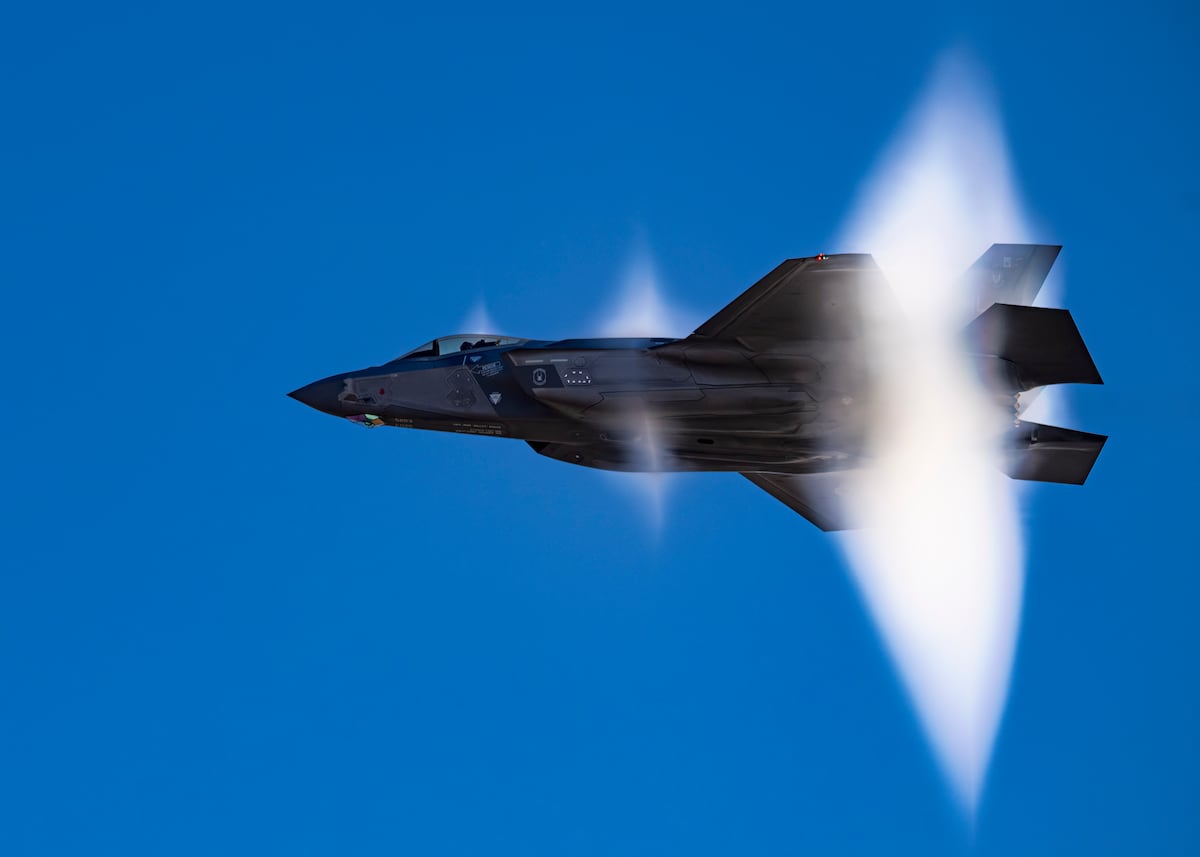The Air Force under a Trump administration could choose to pursue a more advanced successor to the F-35 instead of the costly Next Generation Air Dominance platform to maintain air superiority, outgoing Air Force Secretary Frank Kendall said Monday.
Kendall suggested alternative paths for the Air Force’s future combat fleet at a Center for Strategic and International Studies event at the think tank’s Washington headquarters, in which he outlined a report on where the department needs to be in the next 25 years.
Authored by Kendall, the report, titled “The Department of the Air Force in 2050,” amounts to a sort of valedictory in the waning days of his leadership of the department — and a warning of the threats it could face in decades to come.
“The [Air Force and Space Force] missions don’t fundamentally change [by then], but both services need to go through a transformation” by 2050, Kendall said.
The Air Force will need to procure and maintain the Sentinel intercontinental ballistic missile and B-21 Raider stealth bomber as the core of its portion of the nation’s nuclear triad, Kendall said. It must also accelerate its shift to standoff capabilities that can be launched outside an enemy’s territory, as well as mature survivable stand-in capabilities such as Next Generation Air Dominance, or NGAD, drone wingmen known as collaborative combat aircraft, or CCA, and a next-generation refueling tanker.
Kendall’s report largely calls for continuing the Space Force’s current mission — just at a larger scale and with new architectures and tactics. It predicts growth in the number of satellites in orbit and in the size of the force that will operate them. While today, there are 10,000 guardians in the Space Force, he suggested that by 2050, there will be “multiples of this number.”
China will likely remain the “pacing challenge” for the U.S. and its allies, Kendall said. He predicted China will continue to develop militarily and be able to challenge the U.S. and its allies not only in the Indo-Pacific region but worldwide. Russia will also remain hostile and a “serious threat,” he said, but its economic weaknesses could hinder its military ambitions.
But many “wildcards” exist that make it hard to predict 25 years in the future, Kendall said, such as unforeseen technological advances, a potential nuclear exchange between nations or a Chinese attack on Taiwan. And the department needs to make several decisions to prepare for the possibility of a very different future.
Options on NGAD
One of the most pressing concerns for the Air Force — which will ultimately be up to the incoming Trump administration to decide — is how to modernize its fighter force to keep control of the skies in a future war.
For years, the service has planned to create NGAD as a family of systems with an advanced sixth-generation platform flying alongside CCAs to replace the F-22 Raptor, which was designed three decades ago to specialize in air superiority. The service originally planned to award an NGAD contract in 2024.
However, Kendall said Monday the service would have needed more than $20 billion added to its budget for research and development for NGAD. The potential cost of the platform turned out to be prohibitively expensive, about three times that of the F-35, which would have only allowed the Air Force to buy a small fleet of NGAD fighters.
Kendall put NGAD on hold while the service reconsidered its options and consulted with multiple airpower experts, but felt it was best to let the next administration make the final decision on how to proceed.
The Air Force felt there was “value” in going ahead with NGAD, Kendall said — but without a budget increase, the service needed to pay for other priorities first.
There are alternatives to an F-22 replacement like NGAD, Kendall said, such as another aircraft that would be an F-35 successor. That successor could, like the F-35, be a multirole aircraft that would be designed for controlling CCAs, he said — and could be “much less expensive” than NGAD.
Another alternative could be to further boost the Air Force’s long-range strike capability, Kendall said. Those capabilities could include long-range cruise missiles.
“That’s something we could do in any event,” Kendall said. “It’s relatively inexpensive, and probably makes some sense to do more that way.”
Kendall expressed hesitancy toward suggestions from some — including Trump adviser Elon Musk — that the Air Force should abandon efforts to build another post-F-35 crewed fighter and instead focus on drones.
“I don’t think we’re quite there yet,” Kendall said. “I think that could be considered.”
But a shift away from an Air Force with pilots would require a major cultural shift, Kendall said — one for which he’s not sure the service is ready.
“The culture and history and the legacy of the Air Force, which I have been steeped in … for my whole life, really, is about the role of the pilot,” Kendall said. “Letting go, to some degree, of that, is an incredibly difficult emotional thing for people to do.”
Space Force grows up
Although Kendall’s report doesn’t predict major changes to the Space Force’s mission, it does call for growth and a sense of urgency in response to aggression in the domain from China and Russia.
The document points to a “revolution” in space technology over the last decade that has changed the cost equation for accessing and operating in the space environment, and Kendall said he expects that to continue to shape global reliance on the domain over the next 25 years.
RELATED

“We’re going to need a much bigger, much more capable, much more powerful Space Force,” he said at CSIS. “That’s a transformation that’s already started, and we’ve made some pretty good progress on that since just five years again when the Space Force was created and particularly in the last few years as we’ve moved to acquire and field distributed, resilient architectures.”
As part of that growth, Kendall said, the service will need to “expand substantially” its inventory of offensive, or counterspace, capabilities to defend against and respond to aggression from China and other adversaries. That could include a range of capabilities, he wrote in the report, from on-orbit kinetic weapons to others based on the ground. The service should also build improved battle damage assessment capabilities to mitigate any debris created by destroying satellites.
Another growth area for the service is surveillance and targeting — a mission that has traditionally been performed by aircraft. Under Kendall’s tenure, the Air Force has taken steps to shift that work to space-based sensors and communication networks.
The service will also need to invest in more automation of its space domain awareness systems, which observe, track and catalogue objects in space, Kendall said Monday.
“Trying to monitor all that and track it without a high degree of automation is impossible,” he said. “We’ve got to go much more in that direction.”
The report predicts that by 2050, common space-based sensors will share data with the Defense Department and intelligence community. Commercial data will also feed into those systems, making it harder for an enemy to decide which parts of the architecture to target.
Kendall’s report also suggests that long- and short-range missiles will continue to be the “preferred weapon,” making the Space Force’s missile warning and tracking capabilities increasingly important for the joint force. Those capabilities include space-based sensors that can detect and track ballistic missiles as well as hypersonic weapons, which can travel and maneuver at speeds above Mach 5.
“The resilient architectures being fielded now will evolve and be updated multiple times between now and 2050,” the report states. “Because of their importance to nuclear stability, these systems will be a high priority for reliability and resilience, but they also must be adequately survivable in a conventional conflict.”
Stephen Losey is the air warfare reporter for Defense News. He previously covered leadership and personnel issues at Air Force Times, and the Pentagon, special operations and air warfare at Military.com. He has traveled to the Middle East to cover U.S. Air Force operations.
Courtney Albon is C4ISRNET’s space and emerging technology reporter. She has covered the U.S. military since 2012, with a focus on the Air Force and Space Force. She has reported on some of the Defense Department’s most significant acquisition, budget and policy challenges.
Read the full article here








Leave a Reply